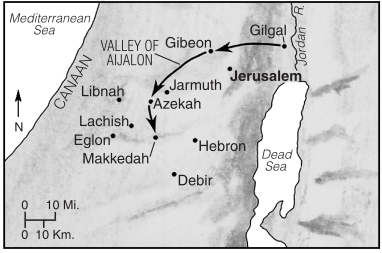
The Battle for Gibeon
Israel attacked the Amorite kings outside of Gibeon and chased them as far as Makkedah.
Open Bible Data Home About News OET Key
OET OET-RV OET-LV ULT UST BSB MSB BLB AICNT OEB WEBBE WMBB NET LSV FBV TCNT T4T LEB BBE Moff JPS Wymth ASV DRA YLT Drby RV SLT Wbstr KJB-1769 KJB-1611 Bshps Gnva Cvdl TNT Wycl SR-GNT UHB BrLXX BrTr Related Topics Parallel Interlinear Reference Dictionary Search
A B C D E F G H I J K L M N O P Q R S T U V W XY Z
GIBEON, GIBEONITES
Place and its inhabitants figuring prominently in the OT from the days of Joshua to the days of Nehemiah, though both were in existence outside these time limits. The site may be identified with confidence as el-Jib some five and a half miles (8.9 kilometers) north of Jerusalem. This identification was proposed as early as 1838 by Edward Robinson. Since the excavation of this site in the years 1956, 1957, 1959, 1960, and 1962, and the discovery of 31 jar handles bearing the name of Gibeon, the identification is placed beyond doubt. Certain geographical and chronological considerations also support this. The location of Gibeon, north of Jerusalem and accessible to that city in the days of David, Solomon, and Jeremiah, as well as its location southwest of Ai combine geographically to support this identification. Further, the periods of occupation at el-Jib revealed by excavation are parallel to historical data supplied by the OT.
The first mention of Gibeon and its inhabitants comes in Joshua 9 and 10 in the days of Joshua, perhaps about 1200 BC. Hearing of the success of the people of Israel at Jericho and Ai, the people of Gibeon, Kephirah, Beeroth, and Kiriath-jearim plotted to obtain a covenant of peace from them. By pretending that they had come from afar and displaying worn-out clothing and footwear as well as dried bread, they were able to deceive Joshua into making a treaty with them. When their deception was discovered, they were sentenced to chop wood and carry water for the Israelites (Jos 9:21-27). Neighboring groups of people from Jerusalem, Hebron, Jarmuth, Lachish, and Eglon, led by Adoni-zedek king of Jerusalem, launched an attack on Gibeon because of its defection to Joshua. The Gibeonites appealed to Joshua, and the Israelites made a forced march from Gilgal to assist them. The enemies of Gibeon were driven down the road to Beth-horon. Their rout was completed with the assistance of hailstones. In that day the sun stood still over Gibeon (10:9-13). Only Gibeon made peace with the incoming Israelites (11:19). In due course the town became part of Benjamin’s territory (18:25; 21:17).

The Battle for Gibeon
Israel attacked the Amorite kings outside of Gibeon and chased them as far as Makkedah.
In the days before David was king, Saul’s general encountered some of David’s men at Gibeon and engaged in an unusual contest at the pool of Gibeon. Twelve men from each side fought and were all thrust through by the swords of their opponents (2 Sm 2:12-17). This encounter was followed by a further skirmish in which David’s men were successful (vv 18-32). Later, David’s nephew Amasa, captain of the rebel army of Absalom, was attacked by Joab at the “great stone which is in Gibeon” (20:8) and left to die in the highway in his blood. In David’s time also, seven sons of Saul were executed “at Gibeon on the mountain of the Lord” (21:1-9) in retribution for Saul’s violation of the ancient covenant between Gibeon and Israel when he slew men of Gibeon (vv 1-6).
There was an important high place still operating at Gibeon in David’s time. The tabernacle of the Lord rested there, and an altar of burnt offering as well (1 Chr 16:39; 21:29). It was at Gibeon, according to 1 Kings 3:3-9, that Solomon had a dream in which Solomon asked for wisdom to govern Israel well (cf. 2 Chr 1:2-13). A second time God appeared to Solomon at Gibeon to assure him that his prayer had been heard and to urge him to walk in God’s ways (1 Kgs 9:2-9). Gibeon was among the cities taken by Pharaoh Shishak in the second half of the 10th century BC. Presumably Gibeon remained an important center during the days of the kings. There was a prophet in Gibeon in the days of Jeremiah, although he prophesied falsely (Jer 28:1-4).
Some of the Gibeonites went into exile in Babylon and a small group returned (Neh 7:25) and assisted Nehemiah in repairing the Jerusalem wall (3:7-8). Later still, Josephus relates that Cestius pitched his camp at Gibeon on his march to Jerusalem in AD 66 (War 2.515-516). Biblical references cover a period from about 1200 BC to about 445 BC, in archaeological terms from the beginning of the Iron I period, through the Iron II period, and into the Persian or Iron III period. We would expect, therefore, to find evidence for at least these periods in an excavation.
See also Conquest and Allotment of the Land; Gibbar.